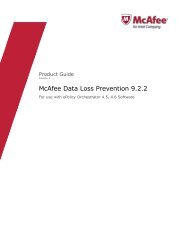Host Intrusion Prevention 7.0.0 for ePO 4.0 Product Guide - McAfee
Host Intrusion Prevention 7.0.0 for ePO 4.0 Product Guide - McAfee
Host Intrusion Prevention 7.0.0 for ePO 4.0 Product Guide - McAfee
You also want an ePaper? Increase the reach of your titles
YUMPU automatically turns print PDFs into web optimized ePapers that Google loves.
Configuring General Policies<br />
The General feature of <strong>Host</strong> <strong>Intrusion</strong> <strong>Prevention</strong> provides access to policies that are general<br />
in nature and not specific to one feature.<br />
Contents<br />
Overview of General policies<br />
Working with Client UI policies<br />
Working with Trusted Network policies<br />
Working with Trusted Applications policies<br />
Overview of General policies<br />
The Client UI policy determines which options are available <strong>for</strong> a Windows client computer,<br />
including whether the <strong>Host</strong> IPS client icon appears in the system tray, types of intrusion alerts,<br />
passwords <strong>for</strong> access to the client interface, and troubleshooting options. Only the password<br />
functionality is used <strong>for</strong> clients on both Windows and non-Windows plat<strong>for</strong>ms.<br />
The Trusted Networks policy lists IP addresses and networks that are safe <strong>for</strong> communication.<br />
Trusted networks can include individual IP addresses or ranges of IP addresses. Marking networks<br />
as trusted eliminates or reduces the need <strong>for</strong> network IPS exceptions and additional firewall<br />
rules. For Windows clients only.<br />
The Trusted Applications Rules policy lists applications that are safe and have no known<br />
vulnerabilities. Marking applications as trusted eliminates or reduces the need <strong>for</strong> IPS exceptions<br />
and additional firewall and application blocking rules. Like the IPS Rules policy, this policy<br />
category can contain multiple policy instances. For clients on both Windows and non-Windows<br />
plat<strong>for</strong>ms.<br />
Settings <strong>for</strong> Trusted Networks and Trusted Applications policies can reduce or eliminate<br />
false positives, which aids in tuning a deployment.<br />
Working with Client UI policies<br />
The Client UI policy determines which options are available to a Windows client computer<br />
protected with <strong>Host</strong> <strong>Intrusion</strong> <strong>Prevention</strong>. These include icon display settings, intrusion event<br />
reactions, and access <strong>for</strong> administrators and client users. For non-Windows clients, only the<br />
password feature is available.<br />
The options in this policy make it possible to meet the demands of three typical user roles:<br />
76<br />
<strong>McAfee</strong> <strong>Host</strong> <strong>Intrusion</strong> <strong>Prevention</strong> 7.0 <strong>Product</strong> <strong>Guide</strong> <strong>for</strong> use with ePolicy Orchestrator <strong>4.0</strong>

















